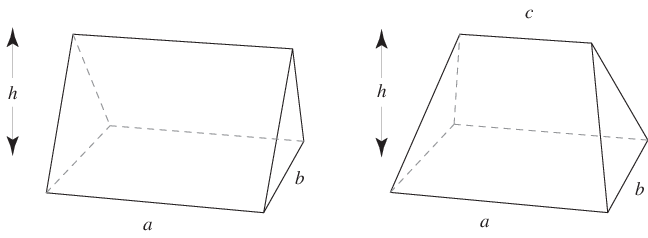The term "wedge" has a number of different meanings in mathematics.
It is sometimes used as another name for the caret symbol.
The term also refers to the notation () used to indicate logical AND.
In solid geometry, ungulae like the conical wedge, cylindrical wedge, and spherical wedge are commonly known as wedges.
|
|
|
However, when the term is used by itself in solid geometry, "wedge" refers a right triangular prism turned so that it rests on one of its lateral rectangular faces (left figure). Harris and Stocker (1998) define a more general type of oblique wedge in which the top edge is symmetrically shortened, causing the end triangles to slant obliquely (right figure). The removal of six identical and oppositely-oriented oblique wedges from a cube gives the endododecahedron.

For an oblique wedge of base lengths and
,
top edge length
,
and height
(right figure), the volume
of the wedge is
|
(1)
| |||
|
(2)
|
In the case of a right wedge ,
this simplifies to
|
(3)
|
The geometric centroid is located at a height
![z^_=(<z>)/V=(int_0^h[a-(a-c)z/h]b(h-z)/hzdz)/V=((a+c)h)/(2(2a+c))](/images/equations/Wedge/NumberedEquation2.svg) |
(4)
|
above the base, which simplifies to for a right wedge
.